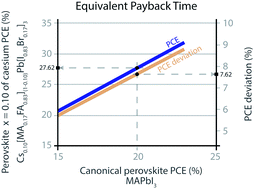当前位置:
X-MOL 学术
›
Sustain. Energy Fuels
›
论文详情
Our official English website, www.x-mol.net, welcomes your
feedback! (Note: you will need to create a separate account there.)
Evaluation of multiple cation/anion perovskite solar cells through life cycle assessment†
Sustainable Energy & Fuels ( IF 5.0 ) Pub Date : 2018-05-09 00:00:00 , DOI: 10.1039/c8se00053k Jaume-Adrià Alberola-Borràs 1, 2, 3, 4, 5 , Rosario Vidal 1, 2, 3, 4, 5 , Iván Mora-Seró 3, 5, 6, 7
Sustainable Energy & Fuels ( IF 5.0 ) Pub Date : 2018-05-09 00:00:00 , DOI: 10.1039/c8se00053k Jaume-Adrià Alberola-Borràs 1, 2, 3, 4, 5 , Rosario Vidal 1, 2, 3, 4, 5 , Iván Mora-Seró 3, 5, 6, 7
Affiliation

|
After the great initiation of perovskite as a photovoltaic material, laboratory efficiencies similar to those of other photovoltaic technologies already commercialised have been reached. Consequently, recent research efforts in perovskite solar cells have been directed towards improving their stability as well as making their industrialisation possible. Record efficiencies in perovskite solar cells (PSCs) have been achieved using as the active material a multiple cation/anion perovskite by combining not only methylammonium (MA) and formamidinium (FA), but also the Cs cation and I and Br as anions, materials that have also demonstrated superior stability. Herein, the environmental performance of the production of such perovskite films was evaluated via life cycle assessment. Our study points out that multiple cation/anion perovskite films show major detrimental environmental impacts for all categories assessed, except for abiotic depletion potential, when they are compared with a canonical perovskite, MAPbI3. In addition, a closer analysis of the materials utilised for the synthesis of the different multiple cation perovskite compositions revealed that lead halide reagents and chlorobenzene produced the most adverse results in terms of impact. However, the former is used in all perovskite compositions and the latter can be avoided by the use of alternative fabrication methods to the anti-solvent method. To this end, FAI, with the current synthesis procedures, is the most decisive compound as it increases significantly the impacts and the c ost in comparison with MAI. A further economic analysis revealed that multiple cation perovskites need a significantly higher photoconversion efficiency to produce the same payback times compared to the canonical perovskite.
中文翻译:

通过生命周期评估来评估多种阳离子/阴离子钙钛矿太阳能电池†
在钙钛矿作为光伏材料的伟大创举之后,已经达到了与已经商业化的其他光伏技术相似的实验室效率。因此,最近在钙钛矿太阳能电池方面的研究工作已致力于提高其稳定性以及使其工业化成为可能。通过不仅结合甲基铵(MA)和甲using(FA),而且结合Cs阳离子和I和Br作为阴离子材料,使用多种阳离子/阴离子钙钛矿作为活性材料,实现了钙钛矿太阳能电池(PSC)的创纪录效率。也表现出卓越的稳定性。在此,通过以下方法评价了这种钙钛矿薄膜的生产的环境性能。生命周期评估。我们的研究指出,与标准钙钛矿MAPbI 3相比,多层阳离子/阴离子钙钛矿膜对所有评估类别均显示出主要的有害环境影响,但非生物耗竭潜力除外。。另外,对用于合成不同的多种阳离子钙钛矿组合物的材料的进一步分析表明,就冲击而言,卤化铅试剂和氯苯产生的不利影响最大。但是,前者用于所有钙钛矿组合物中,而后者可以通过使用反溶剂方法的替代制造方法来避免。为此,在目前的合成程序中,FAI是最具决定性的化合物,因为与MAI相比,它显着增加了影响和成本。进一步的经济分析表明,与标准钙钛矿相比,多种阳离子钙钛矿需要更高的光转换效率才能产生相同的投资回收期。
更新日期:2018-05-09
中文翻译:

通过生命周期评估来评估多种阳离子/阴离子钙钛矿太阳能电池†
在钙钛矿作为光伏材料的伟大创举之后,已经达到了与已经商业化的其他光伏技术相似的实验室效率。因此,最近在钙钛矿太阳能电池方面的研究工作已致力于提高其稳定性以及使其工业化成为可能。通过不仅结合甲基铵(MA)和甲using(FA),而且结合Cs阳离子和I和Br作为阴离子材料,使用多种阳离子/阴离子钙钛矿作为活性材料,实现了钙钛矿太阳能电池(PSC)的创纪录效率。也表现出卓越的稳定性。在此,通过以下方法评价了这种钙钛矿薄膜的生产的环境性能。生命周期评估。我们的研究指出,与标准钙钛矿MAPbI 3相比,多层阳离子/阴离子钙钛矿膜对所有评估类别均显示出主要的有害环境影响,但非生物耗竭潜力除外。。另外,对用于合成不同的多种阳离子钙钛矿组合物的材料的进一步分析表明,就冲击而言,卤化铅试剂和氯苯产生的不利影响最大。但是,前者用于所有钙钛矿组合物中,而后者可以通过使用反溶剂方法的替代制造方法来避免。为此,在目前的合成程序中,FAI是最具决定性的化合物,因为与MAI相比,它显着增加了影响和成本。进一步的经济分析表明,与标准钙钛矿相比,多种阳离子钙钛矿需要更高的光转换效率才能产生相同的投资回收期。











































 京公网安备 11010802027423号
京公网安备 11010802027423号